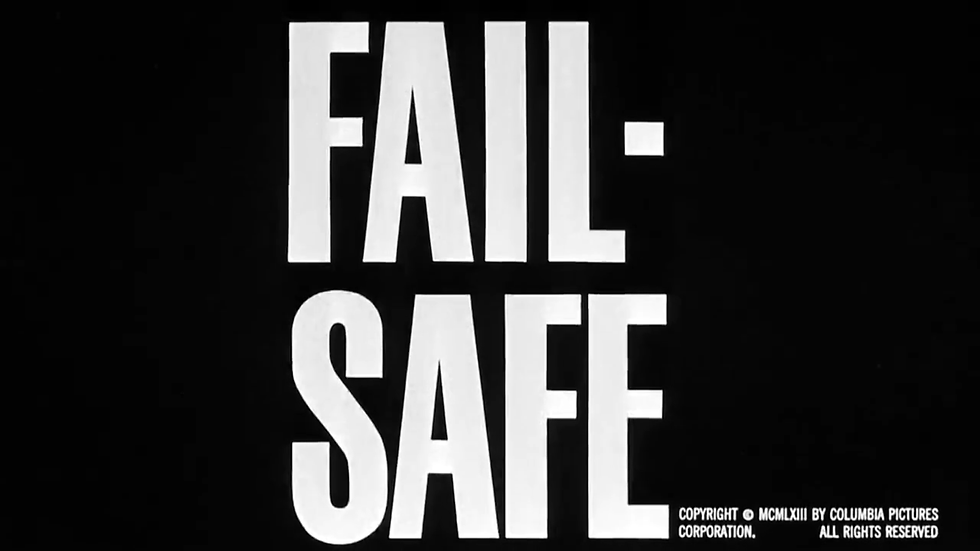Sitting on the Brink of Eternity: 61 Years of Fail Safe (1964)
- Jarrod Mills

- Oct 14
- 4 min read

Fail Safe was adapted from a novel of the same name by two Professors Eugene Burdick and Harvey Wheeler. Based on Wheeler’s short story “Abraham ‘59”, the story was published in a serialized form for the Saturday Evening Post and as a novel during the Cuban missile crisis.
Soon after, pre-production began for a film adaptation and Sidney Lumet was attached to the project by producer Max E. Youngstein. The film was independently produced through Youngstein’s company Max E. Youngstein Enterprises Inc. before being acquired by Columbia Pictures.
On October 7, 1964, Director Sidney Lumet’s fourth feature film opened to a box office bomb as a result of the year’s earlier release of Stanley Kubrick’s Dr. Strangelove or: How I Learned to Stop Worrying and Love the Bomb. The two films had been made simultaneously, Lumet’s independently and Kubrick’s with Columbia Pictures; both having been book adaptations.
An earlier release for Kubrick’s film seemed to have doomed Lumet’s, coming out half a year earlier. Fail Safe’s commercial failure is mainly attributed to Dr. Strangelove being a comedy that satirized much of what Lumet’s film played deadly serious, resulting in the film falling on desensitized ears.
In spite of re-evaluation in recent decades, Fail Safe still sits in a place of being a lesser known Lumet film. But the film packs a prescient punch 61 years later: the politics of nuclear war, government use of early artificial intelligence, consequences of creating more efficient weapons, warmonger tendencies of McCarthyism, to name a few.

Fail Safe takes place in the heat of the Cold War. American nuke-carrying bomber planes are accidentally given a war signal via a mechanical failure in its computer based system. The Pentagon, the President, and the Strategic Air Command center attempt to stop the bombers from destroying Moscow and starting a nuclear war in a joint operation with the Soviet Union’s Premier and Generals.
As the film unfolds, it slowly pressurizes, pushing its variety of characters to emotional brinks as the bombers inevitably reach and destroy Moscow. As a show of good intentions, the President agrees to drop American bombs of equal magnitude on New York City, to prevent total nuclear war.
It’s as devastating as any horror film, but expressed through the various rooms and uniformed men that decorate the film. The film’s small production budget kept scenes involving the most action–bombers, fighter planes, nuclear detonations–are few and far between. But aside from the cheap look of the archival footage used for plane exteriors, the flight simulator interiors are believable.

Henry Fonda as the President seems to be returning to an earlier role he had in Lumet’s 12 Angry Men as Juror #8. Both unnamed characters share a sense of automatic audience trustworthiness and responsibility to justice. Lumet himself believed Fonda to be a perfect fit for the role as he stated on the Fail Safe commentary track that Henry Fonda had a president-like demeanor and that, had Fonda run for President, he would have won.
It is faith in Fonda’s president that creates such a terrifying, hopeless energy in the final 20 minutes, where the worst of the worst becomes inevitable. He is openly vulnerable and shameful in the final moments, finally taking on the burden of guilt with the Soviet Premier for allowing responsibility for the end of the world to be given to machines and not left in the hands of man.
Lumet and blacklisted screenwriter Walter Bernstein are very charitable to the leaders of the film all things considered. One of the film’s unique qualities is its gut punch, humanizing exchange between General Bogan and his Soviet equivalent who share a mutual admiration for the streets of London. The script pulls humanity out of every character of the film and portrays the men as decent; grappling with their prejudices and interpersonal conflicts with World War 3 looming ahead.


It is a film of grim faces in spacious rooms full of and connected to each other by technology. The failure that Lumet asserts is in reducing the human element in important decision making and execution of tasks. Our mutual paranoia with the Soviets and our increasing technological efficiency that parallels theirs means that an accident on either side, no matter how small, has deadly consequences for everyone.
Lumet and Cinematographer Gerald Hirschfeld shoot in a grave black and white, using high contrast lighting to allow shadows to engulf faces, corners, and crevices and create a grave atmosphere. These shadows evoke sometimes startling emotions from the blank, dire expressions of the actors.
The film is certainly dated by the specific technology used in its locations and its all white cast. But it remains relevant to a contemporary audience in its cautionary messaging about mutually assured destruction, military technological accelerationism, and reliance on AI and computers.

In spite of a troubled production, featuring the Federal Government disallowing use of archival footage from SAC and getting stock footage suppliers from selling to Lumet’s production, the film successfully captures the sense of looming dread the Cuban missile crisis had created. Fail Safe undoubtedly has a solid place in Cold War film history, albeit slightly in the shadow of Dr. Strangelove.
Both films ironically serve well as companion pieces, both selling the end of the world in irresponsible hands. Their tones are unique enough from each other that in spite of their similarities, they play very differently and express starkly different emotions.
Fail Safe is a special war film, deserving of its own appraisal for its unique merits. With this October marking its 61st anniversary, it's worth a watch.

